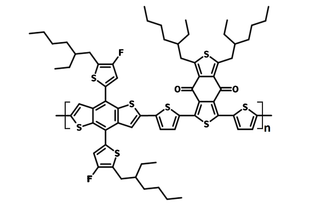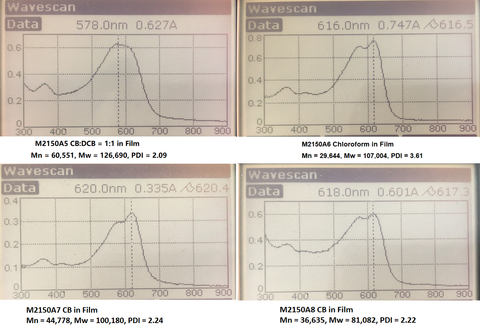PBDB-T-2F (PM6)
CAS Number 1802013-83-7
Luminosyn™ Polymers, Materials, OPV Polymers, Organic Conductors,PM6, for high performance OPV devices
High purity and available for priority dispatch
Overview | Specifications | MSDS | Literature and Reviews | Technical Support
PBDB-T-2F (CAS number 1802013-83-7) is a PBDB-T family member and, like others, has a high OPV device performance. Polymer solar cells with PBDB-T-2F as the donor and ITIC-2F as the acceptor have achieved a power conversion efficiency (PCE) of over 13%.
By introducing two fluorine atoms to each thiophene unit of the benzodithiophene (BDT) side chains in PBDB-T, the HOMO/LUMO energy levels are pulled. Complete phase separation is observed in the PBDB-T-2F:ITIC-2F blend due to the distinct surface tension difference between PBDB-T-2F and ITIC-2F, resulting in a high domain purity in the blend.
A certified efficiency of 14.9% has been demonstrated using PBDB-T-2F (PM6) as the electron donor and Y6 as an acceptor in a single junction non-fullerene polymer solar cell (NF-PSC) [2].
Conjugated semiconducting polymer
As electron donor for high efficient OPV applications
Luminosyn™
High purity, batch-specific GPC data, available larger batch orders and higher molecular weight
Worldwide shipping
Quick and reliable shipping
Green energy materials
Processable in non-halogenated solvents
PBDB-T-2F from Ossila was used in the high-impact paper (IF 18.81), Stretchable and Transparent Conductive PEDOT:PSS-Based Electrodes for Organic Photovoltaics and Strain Sensors Applications, E. Dauzon et al., Adv. Fun. Mater., 30 (28), 2001251 (2020); DOI: 10.1002/adfm.202001251; and paper (IF 29.37), Design Rules for Polymer Blends with High Thermoelectric Performance, O. Zapata-Arteaga et al., Adv. Energy Mater., 12, 2104076 (2022); DOI: 10.1002/aenm.202104076.
The Luminosyn™ Range
General Information
| Full name | Poly[(2,6-(4,8-bis(5-(2-ethylhexyl)-4-fluorothiophen-2-yl)-benzo[1,2-b:4,5-b’]dithiophene))-alt-(5,5-(1’,3’-di-2-thienyl-5’,7’-bis(2-ethylhexyl)benzo[1’,2’-c:4’,5’-c’]dithiophene-4,8-dione))] |
| Synonyms | PBDB-T-F, PBDB-TF, PM6 |
|---|---|
| Chemical formula | (C68H76F2O2S8)n |
| CAS number | 1802013-83-7 |
| HOMO / LUMO | HOMO = -5.45 eV, LUMO = -3.65 eV [1] |
| Processing solvents | o-xylene, chloroform, chlorobenzene and dichlorobenzene |
| Classification / Family | Organic semiconducting materials, Medium bandgap polymers, Organic photovoltaics, Polymer solar cells, Perovskite solar cells, Hole-transport layer materials, NF-PSCs, All-polymer solar cells (all-PSCs). |
Technical Data
| Product Code | Soluble in | Recommended Processing Solvents at 10mg/ml |
|---|---|---|
| M2150A4 |
Chloroform, chlorobenzene and dichlorobenzene |
Chlorobenzene |
| M2150A5 |
Chlorobenzene and dichlorobenzene |
Dichlorobenzene |
| M2150A7 | Chloroform, chlorobenzene and dichlorobenzene |
Dichlorobenzene or Chlorobenzene : dichlorobenzene (v/v = 1:1) |
|
M2150A8/9/10/14 |
o-Xylene, chloroform, chlorobenzene and dichlorobenzene |
o-Xylene (8 mg/ml), chloroform, chlorobenzene |
| M2150A11/12/13 |
Chloroform, chlorobenzene and dichlorobenzene |
Chloroform, chlorobenzene |
Batch Details
| Batch | Mw | Mn | PDI | Stock info |
|---|---|---|---|---|
| M2150A14 | 129,122 | 39,339 | 3.28 | In stock |
Chemical Structure

MSDS Documentation
Literature and Reviews
- Over 14% Efficiency in Organic Solar Cells Enabled by Chlorinated Nonfullerene Small-Molecule Acceptors, H. zhang et al., Adv.Mater., 30, 1800613 (2018); DOI: 10.1002/adma.201800613.
- Single-Junction Organic Solar Cell with over 15% Efficiency Using Fused-Ring Acceptor with Electron-Deficient Core, J. Yuan et al., Joule (2019); doi: 10.1016/j.joule.2019.01.004.
- Over 14% Efficiency in Polymer Solar Cells Enabled by a Chlorinated Polymer Donor, S. Zhang et al., Adv. Mater., 30, 1800868 (2018); DOI: 10.1002/adma.201800868.


